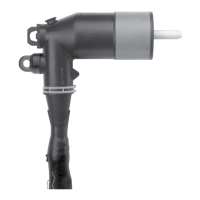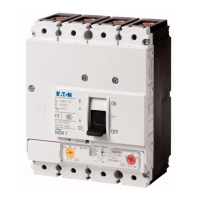Load bushing voltage decreases one percent or more of
the nominal secondary voltage after two quick lower taps
if the control is out of band high and was in the forward
direction before it entered the indeterminate state, or
Load bushing voltage is unchanged or decreases less
than one percent of the nominal secondary voltage after
two quick lower taps if the control is out of band low
and was in the reverse direction before it entered the
indeterminate state.
If the control determines the regulator is not tapping in
the correct direction after two quick taps, the control shall
make two quick taps back to its original position and then
make the needed taps in the opposite direction to bring the
compensated voltage in band.
When the control is in an indeterminate state and needs to
tap, two quick raise taps it will be inhibited if the current tap
position is 15 or 16. When the control is in an indeterminate
state and needs to tap, two quick lower taps it will be
inhibited if the current tap position is -15 or -16.
When the control is in an indeterminate state and needs
to tap, two quick raise or lower taps shall be inhibited if
control determines that two quick taps will violate any of
the following limits:
Soft ADD-AMP limits
P.I. ADD-AMP limits
Leader/Follower Max Deviation limits
Voltage limiting (i.e. two quick taps will exceed the limits)
Bias Co-Generation mode
When FC 56 is set for Bias Co-Generation, a source voltage
is required, either measured or calculated.
The traditional Co-Generation mode of operation assumes
that the primary power source is supplied by a utility
substation on the source-side, physical S bushing, of
the voltage regulator and that this supply is stiff. In this
scenario, the co-generation facility is located on the load-
side, physical L bushing, of the voltage regulator and
the power generated supplements the stiff bus. Voltage
regulation will always be in the forward direction, away from
the stiff bus toward the co-gen facility. See Figure29.
It is possible however, that a co-gen facility is connected
to a loop configured distribution system containing
disconnect and tie switches to isolate and recover sections
of the system. In this scenario, a true power reversal
can occur through the voltage regulator due to a switch
reconfiguration. The traditional Co-Generation mode is
not able to react to a current reversal due to a switch
reconfiguration. If a reversal does occur when the control
is set to Co-Gen mode, the regulator would continue to
attempt forward voltage regulation and tap changer runaway
is likely.
Bias Co-Generation is able to distinguish between reverse
power due to co-generation (Figure34) and true reverse
power flow due to switch reconfiguration (Figure35).
131
INSTALLATION, OPERATION, AND MAINTENANCE INSTRUCTIONS MN225003EN April 2018
CL-7 Voltage Regulator Control

